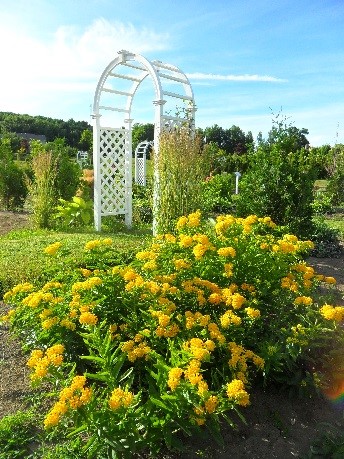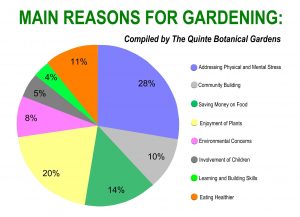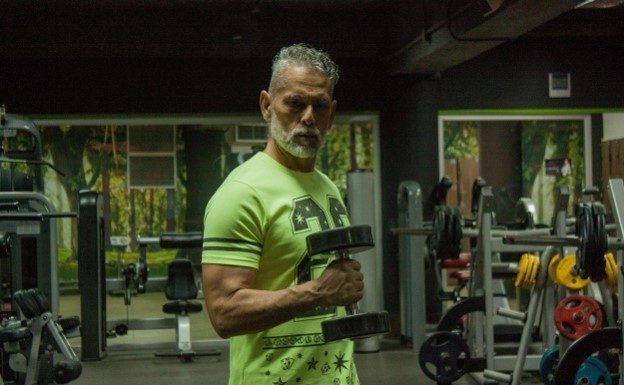Why would a couple of seniors, who should be thinking about retiring, decide instead to build a botanical garden? Answer: because these two seasoned gardening-geeks have first-hand experience about how gardens affect people and we need to let everyone know. This is also a good read if you’d like to go from being a Robot to a Human Being again.
Many moons ago my husband and I moved to the country and started a landscaping business. (Remember the tv program Green Acres?) Our work morphed from climbing the corporate ladder in Mississauga to being “one with the worms” in rural Ontario. Result? Less travelling…more laundry.
Quick – Grab a Shovel!
Fast forward to 2016, and after several winters of planning our long-term dream of creating botanical gardens, what started as “do we take the plunge and build the gardens?” quickly turned into “we HAVE to build the gardens – gardens help people!” Doing our homework on the viability of opening a tourist attraction, we learned about why people love visiting gardens. What an eye-opener! Grabbing our drawings and plans, we started digging that day. It was a gut feeling (albeit a strong one) that we thought building something like this would be a good thing, but didn’t fully understand why.
For the Non-Gardeners Reading This:
Need proof? In the United States MORE PEOPLE VISIT GARDENS THEN DISNEYLAND AND DISNEY WORLD COMBINED. (Dr. Richard Benfield, world authority on garden tourism). And more people visit gardens then Las Vegas! How do you like them apples??? Still think gardening is just a “hobby.” Think again!

Working Like Mad:
People often ask us how on earth did we create 6 acres of botanical gardens in less then two years, when it should have taken five to ten years. The answer is simple: privately-owned gardens (like ours) are non-funded, so if you’re going to build something it better start putting the beans on the table pretty quick. Secondly, we were used to building gardens for customers with our landscaping firm. The only difference was, instead of going to several locations making several gardens – we built several gardens in one place. Project management really kicked in, albeit with MUCH higher volumes of materials and plants.
Zen vs The Cat:
Challenges? It wouldn’t be real life without them! Wrong plants arrived, it poured rain, trucks broke down, it was stifling hot, no plants arrived. And some odd logistical problems… One of the gardens is an authentic Oriental Garden, displaying classic features of both Japanese and Chinese landscapes. Each day we have to rake the soft gravel in the Zen Garden, to reform the “waves” (depicting the oceans) that surround the boulders (depicting mountains). Happily going about our usual suppertime routine, including feeding our cat, a horrifying thought entered our minds. OMG!!! The cat!!! What if our furry friend thinks we just created the world’s largest kitty litter box??? We could swear she was thinking “wow, you shouldn’t have!” Luckily…all was well.
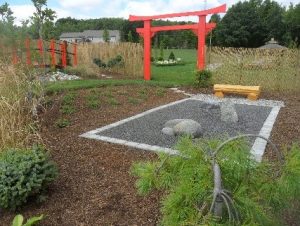
What were we thinking???
As the time approached for our official opening day we were on pins and needles, petrified and losing sleep that we didn’t do enough, second-guessing ourselves about every inch of the gardens. At our age we should be planning leisurely activities, not planting 40,000 plants! We still weren’t sure if the gardens were a brilliant plan or if we were nuts. Then the moment of truth arrived and the gates opened…
People strolled through the gardens, sniffed roses, tasted herbs, rested on benches, read, painted, meandered, took photos, oogled flowers, and chatted with us. Their own experiences and funny stories about gardening (and life) were abundant! When the day was over, we both collapsed on a bench, stunned, with the look on our faces that silently conveyed “did this really happen?”
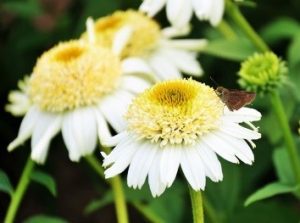
What Is It About Gardens That Help People?
People love gardens for many reasons: to take a break from the rat race; to grow food free of chemicals; as a social event to share experiences, or to be peacefully alone; to enjoy nature; to escape the digital world; to help our environment; to be inspired; to have a picnic or say their wedding vows; for friendly competitions; for the plain and simple love of plants; and a myriad of other reasons. The one closest to our heart is that seniors enjoy a wonderful, non-rushed, safe and comfortable day in the fresh air and sunshine. How come? Because they can do this at gardens – it is an attainable day out for them.
Feeling Good:
Why are gardens so good for the mind? When you plant a flower, pluck weeds, or stroll through a garden, you are redirecting your attention away from stress factors. It’s just you and the earth. No noise, no distractions, no demands. Plants are non-judgemental. It has almost the same effect like the wonderful programs where dogs (and their owners) visit hospitals to make people feel better. The physical act of gardening touches on all five of our senses and anyone can do it. What other “hobby” does that for people?
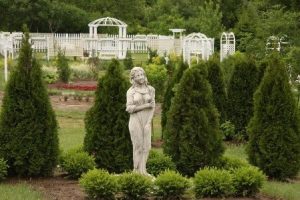
Feedback from People:
Several people have told us that they love walking around the gardens because they can do it at their own pace and nobody bothers them. Visitors to the QBG have said: “What a peaceful place!” “This was wonderful, it’s so relaxing to be here!” “We can’t believe these gardens are here!” And, our favourite: “What a great place to de-stress!”
We wanted to do something structural with this feedback so we accumulated and categorized the information. Our chart reveals the real reasons why visitors came to the QBG in 2018. And believe me, people opened up to us!
Something extraordinary keeps happening at the gardens. When people first arrive, they’re a little quiet, unsure of what they will experience. (Many stayed longer then they first anticipated – and that’s a fun observation in itself!) By the time they leave, they’re smiling, and laughing, and you can just feel a great peace about them. They’re relaxed and look rejuvenated.
Observing Nature: Grand Central Station for Critters!
Gardens offer a plethora of calm activities. They are a photographer’s dream. A little girl was so excited that she caught a photo of a Monarch – she enthusiastically proceeded to show me the 33 other ones she took of the gardens. A group of ladies from Kingston had never heard of a Hummingbird Moth (yes, it’s a moth!), and when they saw 5 of them darting around in the Bird, Bee, Butterfly Garden, they were so thrilled that one of them ran back to tell us! And she was in her 80’s! Artists bring their lunches and spend undisturbed hours painting (although I’m dying to ask what happens when a bug accidentally wonders onto their masterpieces!). People are delighted when they witness the Bumble Bees filling their shopping baskets with pollen, or watch the Honey Bees enjoy their staycations in the Sunflowers.
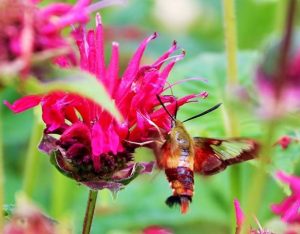
The Human Factor: The Unspoken Truth of How Gardens Really Help People
By now we are all learning (I hope!) how gardens help people physically. To get up to speed help yourself to the list of articles we have on the Health Benefits page of our website (www.qbgardens.ca/health.html). Email us for any of them and we’ll gladly share.
We also need to realize, AND SAY IT OUT LOUD, how this “little hobby” hugely impacts our state of mind.
A great summary extracted from the George Morris Centre’s Literature Review of Documented Health and Environmental Benefits Derived from Ornamental Horticulture Products clearly states how plants and gardens affect our well-being:
Lifestyle:
- Reduce stress and improve productivity (workplace, schools)
- Introduce calming effects and reduced discomforts
- Quicker recovery (hospitals)
- Practice horticultural therapy to improve mind, body and spirit
- Long term care facilities
- Prisons
- Increase human health (e.g., use in medicine)
- Improve life satisfaction and well-being:
- Increase positive emotions
- Improve general quality of life in urban settings
- Create pride in community through community gardens and allotment gardens
- Attention and concentration improvements for children
- Reduce aggression and violence
- Provide space for recreation
- Enhance sport field safety
- Encourage healthy active and passive lifestyle pursuits
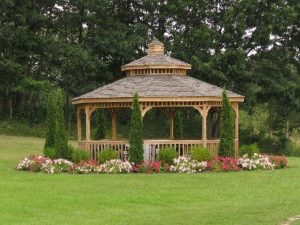
We witnessed these well-being episodes at the QBG, we saw them happen, and they happened with at least 50% of our visitors! These HUMAN stories are only two of them!
One day a lady who arrived at the QBG burst into tears. Clearly, she was upset and kept apologizing for her crying. I wasn’t sure what to do so I instinctively gave her a hug. For the next hour we sat and talked in the gazebo as she explained how she just lost her daughter to cancer. We walked through the gardens, talking, listening, crying and even laughing. When she left – she looked as if a massive weight had been lifted off her shoulders.
Thinking for a long time, I harboured mixed feelings of sadness for this person who was experiencing such deep sorrow, humbled that our flowers offered her a minuscule break from her grief, and grateful that my own health would allow me to keep working. With such clarity, we understood from that moment on – this is why we built the gardens.
An elderly gentleman visited the gardens with his family. As I greeted them, his daughter quietly explained that her Dad loves gardens but hasn’t been in good enough health to travel for many years. She also mentioned he doesn’t speak much these days.
As they meandered through the gardens, they stopped at the Memorial Garden. (We had built this as a tribute to soldiers and our own military parents.) The gentleman sat on the bench for a long time as the family patiently waited. When it was time to go the elderly man came up to me, shook my hand and said two words: “thank you.” I could tell by the looks on their faces, the whole family was surprised to hear him speak. His daughter then mentioned that he was a retired Airforce pilot who had witnessed unspeakable horrors during the war. But today he smiled.
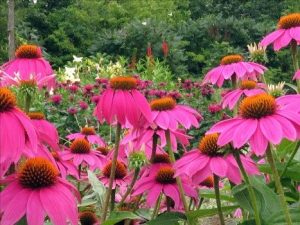
Children visiting the gardens are mesmerized watching the butterfly’s flit around the Zinnias and giggle when they swoop near them. Elderly people marvel at the old-fashioned Hubbard squashes in the Edible Garden which they haven’t seen in a long time. A young couple were laughing as they returned to the gazebo – they both had pink pollen on their noses from sniffing the fragrant Lilies. And people of all ages laugh as they discover their “colour” character in the Colour Wheel Garden.
Gardeners know how swathes of Lupins light up a landscape, and how Dianthus make you want to kick off your shoes and stay there forever. We also know life isn’t always a bowl of cherries. Positive balance, both physical and psychological, need to return to our lives. And gardens answer the call.
So, plant a Petunia, frolic with Foxgloves, or meander through gardens. You’ll be glad you did. And there’s the simple but powerful emotional connection between gardens and humans…being happy.

















